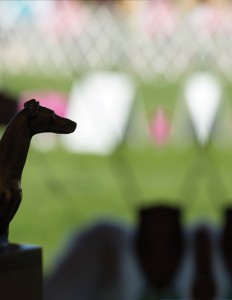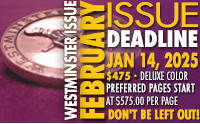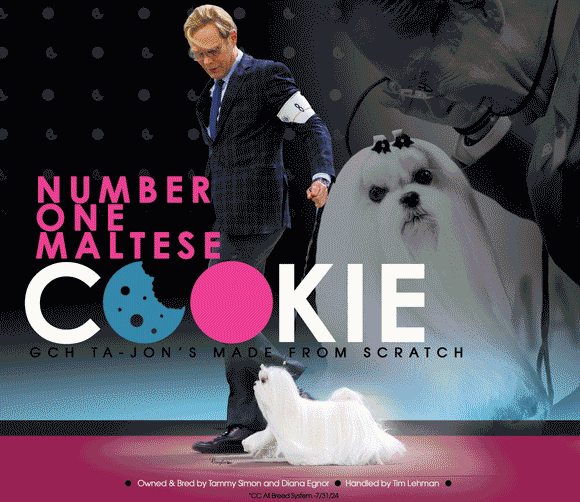From The CC Vault: Widening The Winner’s Circle
Originally published May 2013
by Pat Hastings
 Anyone who knows me will tell you that I have an opinion on just about every aspect of the dog world. If you and I have not met yet, allow me to introduce myself. I began in dogs as an owner — simply one among millions with a love of dogs. I became an owner-handler, breeder, 4-H dog club leader and went into professional handling when I married E.R. Bob Hastings. Upon our retirement in 1990, we both went into judging. I was show chairman for the 1995 Doberman national specialty and for more than twenty years have presented numerous seminars across the country, which hopefully are helping to create better dog people. From this lifetime in dogs, I continue to learn, observe, and formulate some potentially valid conclusions and solutions that always seem to emanate from idle questions.
Anyone who knows me will tell you that I have an opinion on just about every aspect of the dog world. If you and I have not met yet, allow me to introduce myself. I began in dogs as an owner — simply one among millions with a love of dogs. I became an owner-handler, breeder, 4-H dog club leader and went into professional handling when I married E.R. Bob Hastings. Upon our retirement in 1990, we both went into judging. I was show chairman for the 1995 Doberman national specialty and for more than twenty years have presented numerous seminars across the country, which hopefully are helping to create better dog people. From this lifetime in dogs, I continue to learn, observe, and formulate some potentially valid conclusions and solutions that always seem to emanate from idle questions.
For example, what happened to the value of winning Best of Breed? When did the emphasis shift to Group and Best In Show wins? How did the records get so totally out of this world? Who would have ever dreamed that the day would come when 100 Bests In Show would be an attainable goal for a top dog — yet the record is now well over 200! 275 to be exact! And 100 has become a bit ho-hum!
Old-time dog people who grew up with a thorough knowledge and understanding of animal husbandry and gave priority to the welfare of their dogs would turn over in their graves if they knew what modern exhibitors put their dogs through. For example, it is hard enough on people to board commercial airliners and fly around the country every weekend (just ask any judge). Imagine the wear and tear on dogs being boarded in those dark, smelly, crowded baggage compartments to fly from one show to the next every weekend. Once in awhile, a trip to the National Specialty or Madison Square Garden or some of the more prominent specialty shows is one thing; week-in, week-out each Friday, Saturday, and Sunday is ridiculous to me. Today it is even running the other four days of the week also.
There was a time when everyone showing dogs had an equal chance to put together a winning package. More and more, however, it appears that if you want your quality dog recognized with top wins, you’d better have money — lots of money.
I feel the most negative part of a dog show is when the catalogs come out in the morning and people start talking about who is going Best In Show.
I read somewhere that 20 percent of the AKC judges judge 80 percent of the shows. If this assertion is accurate, how did this happen? Are the judges within that 20 percent the only quality judges? Or even the best?
Although that assessment may sound a bit like David and Goliath, I think I may have a solution that could give David the edge. The sport of purebred dogs is maintained, for the most part, not by the Goliaths but by the average, local dog people. It’s all of the “little” people who make up the majority of entries at dog shows. They are the people who do most of the work putting on dog shows from one end of this country to the other.
AKC rule changes begin with the delegate body, and that, folks, is us. Our kennel clubs should be member clubs with a delegate to AKC and our delegates should vote according to the will of the club’s membership. In other words, we the people have the power to make the rule changes that would help put the importance and emphasis back on the breed level and rejuvenate equal opportunity in the ring.
What I propose is a rule change to allow a club to change the way they hire judges for groups and Best In Show. Let’s give them the opportunity to hire at the breed level only: we would print the premium list as usual except that it would not list judges for group and Best In Show. As the time for group judging nears, the names of all judges on the slate who are eligible to judge each group would be thrown in a hat (box, bowl, whatever) for a drawing to determine that group’s judge. Each drawing would take place only after the dogs entered the group ring.
This same process would be applied to Best In Show. If judges are hired for a weekend, circuit, or cluster with numerous shows involved, the names of previous group and Best In Show judges would be excluded from the drawing each day to eliminate duplications. The rule regarding judging conflicts, time, and mileage would have to be modified for groups and Best In Show; however, since judging at those levels would always be the luck of the draw, this should not be a problem.
THE BENEFITS
What this minor change could accomplish is exciting to ponder. The emphasis would be returned to the breed level and people would be submitting entries for that purpose. The big winning and records would be a bonus — the icing on the cake — instead of the primary purpose of showing. The airlines would have fewer handlers (and dogs) on their passenger manifests; after all, who is going to go to the trouble of flying across the country when there is only one chance in two, four, six, or more that the handler will get the group judge of his choice? The odds are even worse when it comes to Best In Show. Certainly, some of the mad dashers will continue, but most of them should fall away.
As a result, the records would return to earth. If handlers stop flying around to show to their judges of choice and everyone has an equal chance to win, the records would have greater meaning.
Insofar as judges are concerned, more judges would have an opportunity to judge groups and Best In?Show, thus increasing their exposure and experience. If group and Best In Show judges are drawn in lottery fashion instead of being hired for their name recognition, maybe a larger percentage of judges would be hired. This rule might even create better judges because the only way to improve your judging skills is to judge. It is decidedly a learn-by-doing position.
Moreover, many judges resent it when exhibitors and handlers trail along after their every group and Best In Show assignment. When a handler or exhibitor shows a dog you really like, your credibility is at risk if you don’t put that dog up. On the other hand, you are seen as playing favorites if you do put that dog up. Also the presence of these dogs may prevent a judge from giving a local dog a nice win.
Money would once again be a secondary element in having top winning dogs. Everyone would walk into the group and Best In Show rings on an even footing. How many of us have lost a group 1 or maybe even the elusive Best In Show to someone who flew in to take the win? Even those who continue to fly in will have the same odds as local owner-handlers because they won’t necessarily be showing to their judges of choice.
One more beneficiary of this change — believe it or not — could be the dog magazines. Top-winning dogs are still going to be advertised, but a more level playing field could create greater numbers of winning dogs. And let’s face it — when we win, we want to tell the world we won.
This single rule change could make all of us in the sport of purebred dogs feel like winners.
Short URL: https://caninechronicle.com/?p=304533
Comments are closed












